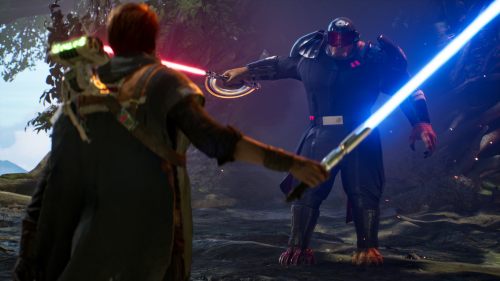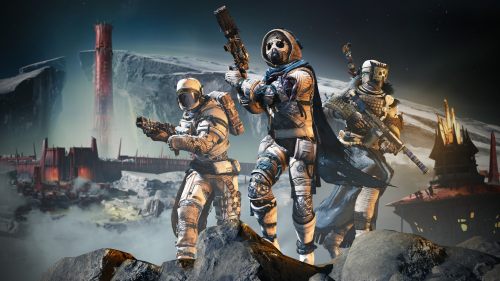DESTINY 2 Game Review: Welcome Home, Guardian
It's hard for me to write objectively about Destiny. Reviews shouldn't be objective, of course, but Destiny holds a special place for me. The first game had soaring strengths and deep flaws, but its importance to me is more personal than that. The affection I feel for Destiny is akin to what World of Warcraft players must feel towards that game. It’s more than just one of the most tightly-tuned shooters ever made; it’s a place to socialise, to unwind, to watch gear statistics tick ever upwards while shooting the breeze (and aliens) with friends.
And so we come to Destiny 2: a sequel in name and reboot in purpose that builds on three years’ worth of player data and experience. It’s a big bet for Bungie, which hopes to answer complaints about confusing storytelling, lack of open-world activities, and esoteric progression systems, as well as to lure in new players with a blockbuster campaign and streamlined multiplayer. Happily, the studio has largely succeeded: Destiny 2 sports much more content and simpler systems than its predecessor, without sacrificing the top-flight space-wizard shooter gameplay. But it’s not without its own new quirks, either.
Destiny 2's proudest improvement is its campaign and storytelling, though it’s far too transparent how hard Bungie worked to achieve it. Moving on from its predecessor’s weirdly metaphysical storylines, Destiny 2’s campaign is a simple resistance story - an easy but effective option in video games. Missions now feature actual cutscenes and scripted material, including sequences where villains discuss their motivations with each other - unthinkable in the previous game. The returning characters (like enthusiastic Crucible boss Shaxx, Lance Reddick's over-serious Zavala, and Gina Torres' Ikora) have been beefed up and their personalities intensified, while new characters (like tea-drinking SAS type Devrim, malfunctioning AI Failsafe, and Muppet-esque mad scientist Asher) border on Borderlands absurdity. There’s even a conclusion - a real, actual conclusion - that feels as though things have changed due to your play. It's amazing how much basic things like these impress in Destiny 2, but that's just how rushed and flawed the original was.
While “more banter” is definitely an improvement from whatever drove Destiny 1’s scriptwriting, the new, sillier tone feels a little like Overwatch: seemingly tailor-crafted to maximise memeable moments, cosplay, and fanfic. Constant callbacks to Destiny 1 in-jokes support this theory: there’s no reason why, say, Nathan Fillion’s Cayde-6 would reference meme dialogue from the first game, but reference it he does. It’s so blatantly targeted at the nostalgia centres of Destiny players’ brains - I’d be lying if I said it didn’t work, and I’d be lying if I said I didn’t hate myself for allowing it to.
More identifiable characters lend the missions more emotional weight, but it’s the level design that impresses the most. From the opening mission, with the first game’s social space under attack, to the gleefully superheroic final boss battle, and even the game’s one-off Strike missions, Bungie has delivered the campaign Destiny 1’s anemic offering aspired to but never achieved, with a wide range of game mechanics and moods. Nothing’s particularly original here, of course - several missions specifically recall some of Halo’s finer moments - but it’s all extremely well-executed, with terrific music and stunning environmental design.
While new players will lack understanding of Destiny lore, that’s not such a big issue. The sequel is much better at communicating than the original, thanks in no small part to finally moving its lore drops from a mobile app into the actual game. The real bonus of longtime play comes in the form of pre-existing investment in the world and its characters. For returning players, it means something that humanity must retreat to a farm as its base of operations. There’s a sense of comfort that comes from just jumping back into this world in a new, more vibrant way - especially if accompanied by the same friends that joined you the first time.
Destiny 2’s open-world environments are among its best features, representing one of the starkest improvements over the original game. Located on Earth, the moons Titan and Io, and rogue planetoid Nessus, they play host to the game’s missions, but also to a range of new, more casual activities. Visually and practically, they’re dense with detail, with a great deal more verticality and bespoke areas than before. Bungie’s gift for skyboxes is on full display, while environments like abandoned overgrown cities, floating industrial platforms, crashed space freighters, and enormous alien banyan trees provide varied and attractive backdrops for all the shooting. I actually said “whoa” at a couple points, so pretty are the game’s environments - like something out of No Man’s Sky(‘s promotional material).
Those patrol areas also offer new additions to Destiny 2’s gameplay. Where once the open-world activities were limited to repetitive Patrols (kill some aliens! Go here! Kill more dudes!), Destiny 2's worlds are littered with activities, ranging from Adventures (proper, voice-acted sidequests revealing the area’s backstory) to Lost Sectors (dungeons, effectively, with minibosses and loot caches) to a liberal smattering of hidden chests and bits of environmental storytelling. Public events - spontaneous, time-limited bursts of activity - have also been expanded, ranging from high-value targets and speeder bike gangs to more complex and rewarding tasks. I rarely found myself with nothing to do, which is a massive step up from the ghost towns of Venus and Mars.
Multiplayer has seen a considerable overhaul in Destiny 2, with all matches now taking on a 4v4 structure, and matchmaking streamlined into Quickplay and Competitive modes. The game modes themselves (chosen at random) are the same solid mix, with the new addition of the CounterStrike-esque Countdown mode, but scoring systems now further focus on team play, and the UI has been optimised for legibility and clarity. In my unscientific analysis, matches feel tighter and fairer now, with fewer instances of teams running rough-shod over their competitors. That’s partly due to smaller team sizes, but it’s also where the new weapon loadout system really shines. Gone is the “special” slot for weapons like shotguns and sniper rifles; those have been moved to the limited-ammo “power” slot alongside rocket launchers, swords, and the like. Replacing specials are energy weapons, which fit roughly the same archetypes as primaries - auto, scout, and pulse rifles, hand cannons, sidearms, and submachine guns - but simply do energy damage instead of kinetic damage. Energy weapons feel more like “alternate” weapons instead of situationally dominant ones, which means less abuse of the weaponry "meta" that at times made the first game’s matches so irritating.
For all the high-profile upgrades and feature additions, the biggest sighs of relief come from Destiny 2’s under-the-radar quality of life improvements. The in-game map is now actually useful, showing nearby activities, loot, and (finally!) impending public events; it can be opened and used at any time, eliminating the need to “go to orbit”; and players can even use it to fast-travel, catching Destiny up with games from a decade-plus ago. Character upgrades make much more sense now, with an XP-based upgrade-point system and straightforward skill trees. Quest and inventory management is less of a pain, with all quests available on a handy sidebar, and the weekly activities, challenges and milestones - Destiny 2’s endgame bread and butter - are helpfully labelled. Anything in Destiny being helpful is a wholly novel concept.
The real question mark hovering, Warlock-like, above Destiny 2 is of course how its endgame will treat players in the long term. As expected, the grind is still real - especially once you reach power level 265 - and currently, the activities yielding high-level gear are limited to the raid, Nightfall strikes, and weekly milestones. Some players have already reached the maximum power level, which frankly blows my mind; most will plug away slowly, maybe even never getting there. But the grind doesn’t hurt as much in Destiny 2, thanks to the activities themselves being more interesting. Who would have thought that designing fun activities would be a positive choice?
On the other hand, cosmetic items in Destiny 2 have sparked considerable controversy, thanks mostly to the transition of Shaders (paint jobs for your gear) to single-use, purchaseable items. Personally, I don’t get the ballyhoo. You can earn shaders - and even the new emotes, like the Monty Python silly walk, the Arrested Development chicken dance, and the Confused Travolta - through continued gameplay and random drops. There is no need to plug real money into Destiny 2’s microtransaction system unless you’re obsessive about customising every single piece of your gear. Destiny fashion has never been my bag: I’m more about chilling out while shooting aliens and chatting with my friends (or, if playing solo, listening to podcasts and audio books).
Destiny 2’s core conceit - that its villain Ghaul, in enacting his master plan, forces players’ characters to start all over again - is a fitting metaphor for the game itself. A sequel to a flawed game, the onus was on Bungie to fix its mistakes and deliver on its original promise of an epic, connected shooter. Is it “the game Destiny 1 should have been”? Well, no. Destiny 2 would not be what it is without the learning involved in the development and operation of Destiny 1, which was at the time something of an experiment. But Bungie has taken that data and feedback and crafted a game which feels richer and more meaningful, trading on its world-building for returnees and its unbeatable shooting for newcomers.
And given that I’m moving countries right now, the ability to hang out and have fun with my friends back home far outweighs any worries about microtransactions or gear grind. It even outweighs the fact that you still can’t dismantle items directly from the Postmaster. Destiny 2 is a new video-game home for me, as lame as that sounds, and it's one I'm happy to live in.



